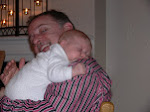Brooklyn, Clinton/Washington station, waiting for a C train. 8:15 on a recent weeknight. I see a 30-something white man on the sparsely populated platform. Wiry, fidgety, he looks up from his study of a subway station ad, catches my eye. "What's the same about all these people?" He gestures to 30 or so portraits in a grid, all faces seemingly enthusiastic about reporting suspicious activity to authorities. "Just look. It'll come to you." I look. "It's easy!" Well, I say -- they all look happy. "Their noses! Look at their noses!" His words burst from a restraining dam. "See how they're all wide and flat?" Though the racial and cultural mix of this public service campaign has always struck me as exemplary, at a glance the many-hued noses do seem similarly shaped. "They're victims! See how their eyes are spread wide apart? The noses all flat? They're prey, not predators. Victims!" He paces on the platform, spins. He seems eager to expound. Lank hair curls from under his knit cap. I check: his nose is hawkish. I hear you, I say, moving on, not pausing to determine the distance between his eyes.
Wednesday, December 7, 2016
Friday, December 2, 2016
"No Such Things As Facts"
The political news comes in waves; it’s hard to chart one before the next comes crashing. That’s a truism of the stretch when presidents-elect name cabinet members and make decisions with years or decades of consequences. But in the Age Of Trump the waves seem mightier.
And the president-elect, as is his wont, continues to toss bright shiny tweets that media magpies can’t resist -- a horde of pop-culture trash. (Hamilton! SNL! Three million illegal votes! Flag burners!) Friends debate whether this is a distraction tactic of Machiavellian brilliance or evidence of an egomaniacal simpleton with the impulse control of a hormonal teen. The debates themselves distract. I’ve already declared my intention to ignore, to the extent possible, Trump’s bluster. The smartest take I saw this week was a Storified set of tweets from Elliot Lusztig.
Journalists, meanwhile, rip hair and rend garments and try to create strategies for covering the new president. Here are a few takes I’ve appreciated this week.
1). NYU prof Jay Rosen makes a point we should have all learned from Sen. Joseph McCarthy’s fact-free accusations: Focus, when warranted, not on the charge itself but its absence of evidence.
2). James Fallows notes that contemporary U.S. news media “are not built” to cover a leader with no evident capacity to distinguish truth from lies. One of his three suggestions echoes Rosen; a second highlights the need to “fight for reality” (and democracy) by citing another terrific essay by Ned Resnikoff at Think Progress; and a third suggests the media should call narcissistic behavior by its proper name.
3). Fallows encountered this week on the Diane Rehm radio show a Trump stalwart, “journalist and patriot” Scottie Nell Hughes, who opined “there are no such things as facts.” (You can hear Hughes’s remarks around the 14:40 mark of the show.)
That was echoed by former Trump campaign manager Corey Lewandowsky, quoted in The Washington Post: “This is the problem with the media. You guys took everything that Donald Trump said so literally. The American people didn’t. They understood it. They understood that sometimes — when you have a conversation with people, whether it’s around the dinner table or at a bar — you’re going to say things and sometimes you don’t have all the facts to back it up."
4). So facts neither matter nor exist. The answer? According to WaPo Editor Marty Baron: Do our job. “The ultimate defense of press freedom lies in our daily work.... Because holding the most powerful to account is what we are *supposed* to do. If we do not do that, then what exactly *is* the purpose of journalism?”
5). Adding vital context, Matt Lees in The Guardian has a terrific piece on how the sexist Internet trolls behind Gamergate acted as a precursor for far-right Trumpians on how to terrorize foes and influence the press and control a story, all in the name of “ethics” and “justice.” It’s a lesson in contemporary propaganda.
6). Bonus links: Lees refers to Umberto Eco’s New York Review Of Books 1995 essay outlining 14 elements common to fascist regimes. (Eco calls it “ur-Fascism.”)
One rule: Ur-Fascism uses Newspeak (from Orwell’s “1984”), “an impoverished vocabulary, and an elementary syntax, in order to limit the instruments for complex and critical reasoning.” That resonated with me especially after reading this Atlantic article by Andrew Simmons, a creative Marin County high school instructor, on teaching “1984” in the Age Of Trump. I have encountered students similar to the young woman who breezily tells Simmons that the novel is “too long, too confusing, and too full of words no one used anymore.”
I wish you all a week filled with complex syntax and enriched vocabulary.
Subscribe to:
Posts (Atom)
